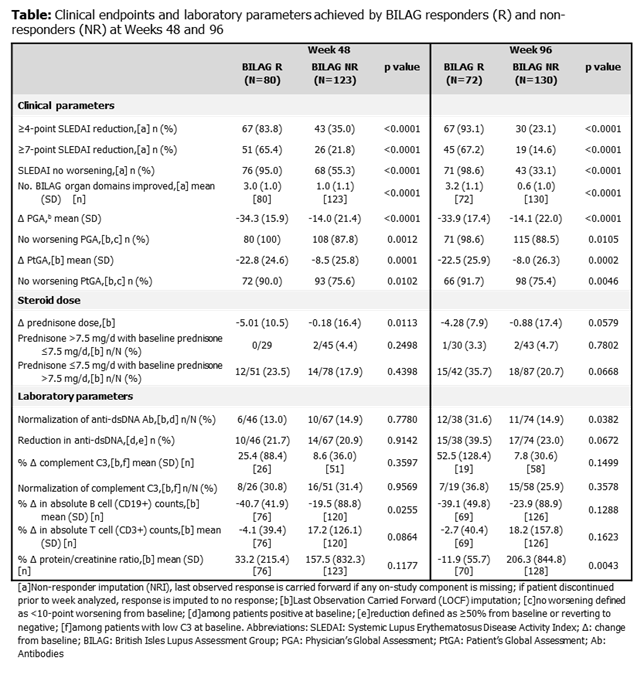Session Information
Session Type: Abstract Submissions (ACR)
Background/Purpose
Epratuzumab is a monoclonal antibody in development for the treatment of systemic lupus erythematosus (SLE) that binds CD22, promoting the natural inhibitory function of CD22 on the B-cell receptor.1,2 In EMBLEM™ (dose-ranging Phase 2b study [NCT00624351]), and its open-label extension (OLE; SL0008 [NCT00660881]), epratuzumab produced sustained, clinically relevant improvements in patients (pts) with moderate-to-severe SLE as measured by British Isles Lupus Assessment Group (BILAG) response. BILAG response forms the basis of BILAG-Based Composite Lupus Assessment (BICLA), described elsewhere.3 This study aimed to correlate BILAG response with clinical and laboratory parameters during epratuzumab open-label therapy, and to examine maintenance of improvements in BILAG organ systems.
Methods
All EMBLEM™ pts completing 12 weeks (wks) of blinded treatment, or who discontinued due to lack of efficacy but completed ≥8 wks, were eligible for OLE entry, in which all pts received 1200mg epratuzumab at Wks 0 and 2 of repeating 12-wk cycles. Post-hoc analysis evaluated changes from EMBLEM™ baseline in clinical and laboratory parameters in BILAG responders (R) vs non-responders (NR) (OLE Wks 48 and 96). BILAG response was defined as BILAG A to B/C/D, all Bs to C/D, no new BILAG A or ≥2 new B scores; non-response as lack of improvement, worsening or withdrawal prior to assessment. Achievement and maintenance of a low disease activity state was defined as disease activity improvement in all systems with BILAG A or B scores at EMBLEM™ baseline to C or D in the OLE, with no categorical deterioration from baseline levels prior to improvement, and no reversion to baseline A or B levels once improvement had occurred.
Results
203 pts entered the OLE; 80 (39%) achieved a BILAG response at Wk48, and 72 (36%) achieved a BILAG response at Wk96. At both timepoints, responders had significantly greater reductions in Systemic Lupus Erythematosus Disease Activity Index (SLEDAI), Physician Global Assessment (PGA) and Patient Global Assessment (PtGA) scores, and improvements in greater numbers of BILAG organ domains than non-responders (Table). At Wk48, responders had greater reduction in concomitant steroid doses (not significant at Wk96 [Table]). Laboratory parameters associated with BILAG response are shown in the table. Improvements in individual BILAG organ systems were maintained in >50% of pts in 4/9 body systems.
Conclusion
BILAG responders in the OLE were more likely to achieve improvements in a range of clinical and laboratory parameters, including SLEDAI, PGA and PtGA scores, and show changes in absolute B-cell (CD19+) and T-cell (CD3+) counts. Additionally, improvements in individual body organ systems were maintained.
References
1. Daridon C. Arth Res Ther 2010;12:R204
2. Sieger N. Arth Rheum 2013;65:770
3. Wallace D. Ann Rheum Dis 2014;73:183-190
Disclosure:
R. A. Furie,
UCB Pharma,
5;
M. Petri,
UCB Pharma,
2,
UCB Pharma,
5;
C. Gordon,
GlaxoSmithKline, MedImmune, Merck Serono, Paraxel and UCB Pharma,
5;
V. Strand,
AbbVie, Afferent, Amgen, Biogen Idec, Bioventus, BMS, Carbylan, Celgene, Celltrion, CORRONA, Crescendo, Genentech/Roche, GSK, Hospira, Iroko, Janssen, Lilly, Merck, Novartis, Pfizer, Regeneron, Sanofi, SKK, Takeda, UCB, Vertex,
5;
C. Galateanu,
UCB Pharma,
3;
S. Bongardt,
UCB Pharma,
3;
W. Koetse,
UCB Pharma,
1,
UCB Pharma,
3;
D. J. Wallace,
Bristol-Myers Squibb, Genentech, Biogen IDEC Inc, GlaxoSmithKline, Human Genome Sciences Inc, MedImmune, Novo Nordisk, UCB Pharma,
5.
« Back to 2014 ACR/ARHP Annual Meeting
ACR Meeting Abstracts - https://acrabstracts.org/abstract/correlation-of-laboratory-and-clinical-parameters-with-british-isles-lupus-assessment-group-response-in-an-open-label-extension-study-of-epratuzumab-in-systemic-lupus-erythematosus/

